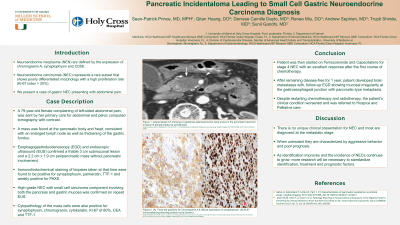Sunday Poster Session
Category: Stomach
P1377 - Pancreatic Incidentaloma Leading to Small Cell Gastric Neuroendocrine Carcinoma Diagnosis
Sunday, October 22, 2023
3:30 PM - 7:00 PM PT
Location: Exhibit Hall

Has Audio

Sean-Patrick A. Prince, MD, MPH
University of Miami/Holy Cross Hospital
Pompano Beach, FL
Presenting Author(s)
Sean-Patrick Prince, MD, MPH1, Qitan Huang, DO2, Denisse Camille Dayto, MD2, Renee Miu, DO2, Andrew Sephien, MD2, Trupti Shinde, MD2, Sunil Gandhi, MD2
1University of Miami/Holy Cross Hospital, Pompano Beach, FL; 2HCA Healthcare/USF Morsani GME Consortium: HCA Florida Citrus Hospital, Inverness, FL
Introduction:
Neuroendocrine neoplasms (NEN) are defined by the expression of chromogranin A, synaptophysin and CD56. Neuroendocrine carcinomas (NEC) represents a rare subset that shows poorly differentiated morphology with a high proliferation rate (Ki-67 index > 20%). Typically, NENs are frequently found in the lung with gastric NENs comprising only 4% of all NENs. We present a case of gastric NEC presenting with abdominal pain.
Case Description/Methods:
A 79-year-old female with a past medical history of hypertension presented with left-sided abdominal pain. Patient was sent for abdominal and pelvic computed tomography with contrast that revealed a mass at the pancreatic body and head, consistent with an enlarged lymph node as well as thickening of the gastric fundus suspicious for malignancy.
Lab studies revealed a carcinoembryonic antigen level of 26.9 ng/mL. Esophagogastroduodenoscopy (EGD) and endoscopic ultrasound (EUS) revealed a friable 3 cm submucosal lesion and a 2.2 cm x 1.9 cm peripancreatic mass without pancreatic involvement. Samples taken including core needle biopsies of the peripancreatic mass and submucosal lesion were sent for pathology.
Further work-up revealed the peripancreatic mass expressed features consistent with neuroendocrine expression. Immunohistochemical stains were positive for synaptophysin, pankeratin, TTF-1 and weakly positive for PAX8.
Repeat EUS with fine-needle biopsy showed high-grade NEC with small cell carcinoma component involving both the pancreas and gastric mucosa. Cytopathology of the tumor cells were positive for synaptophysin, chromogranin, cytokeratin, Ki-67 of 60%, CEA and TTF-1. Patient was then started on guideline directed therapy for stage 4 NEC with an excellent response after the first course of chemotherapy.
Patient remained disease-free for 1 year, until recurrent disease was detected with evidence of brain metastasis. Follow-up EGD showed mucosal irregularity at the
gastroesophageal junction with pancreatic-type metaplasia. Despite restarting chemotherapy and radiotherapy, the patient's clinical condition worsened and was referred to Hospice and Palliative care.
Discussion:
There is no unique clinical presentation for NEC and most are diagnosed at the metastatic stage. When untreated they are characterized by aggressive behavior and poor prognosis. As identification improves and the incidence of NECs continues to grow; more research will be necessary to standardize identification, treatment and prognostic factors.
Disclosures:
Sean-Patrick Prince, MD, MPH1, Qitan Huang, DO2, Denisse Camille Dayto, MD2, Renee Miu, DO2, Andrew Sephien, MD2, Trupti Shinde, MD2, Sunil Gandhi, MD2. P1377 - Pancreatic Incidentaloma Leading to Small Cell Gastric Neuroendocrine Carcinoma Diagnosis, ACG 2023 Annual Scientific Meeting Abstracts. Vancouver, BC, Canada: American College of Gastroenterology.
1University of Miami/Holy Cross Hospital, Pompano Beach, FL; 2HCA Healthcare/USF Morsani GME Consortium: HCA Florida Citrus Hospital, Inverness, FL
Introduction:
Neuroendocrine neoplasms (NEN) are defined by the expression of chromogranin A, synaptophysin and CD56. Neuroendocrine carcinomas (NEC) represents a rare subset that shows poorly differentiated morphology with a high proliferation rate (Ki-67 index > 20%). Typically, NENs are frequently found in the lung with gastric NENs comprising only 4% of all NENs. We present a case of gastric NEC presenting with abdominal pain.
Case Description/Methods:
A 79-year-old female with a past medical history of hypertension presented with left-sided abdominal pain. Patient was sent for abdominal and pelvic computed tomography with contrast that revealed a mass at the pancreatic body and head, consistent with an enlarged lymph node as well as thickening of the gastric fundus suspicious for malignancy.
Lab studies revealed a carcinoembryonic antigen level of 26.9 ng/mL. Esophagogastroduodenoscopy (EGD) and endoscopic ultrasound (EUS) revealed a friable 3 cm submucosal lesion and a 2.2 cm x 1.9 cm peripancreatic mass without pancreatic involvement. Samples taken including core needle biopsies of the peripancreatic mass and submucosal lesion were sent for pathology.
Further work-up revealed the peripancreatic mass expressed features consistent with neuroendocrine expression. Immunohistochemical stains were positive for synaptophysin, pankeratin, TTF-1 and weakly positive for PAX8.
Repeat EUS with fine-needle biopsy showed high-grade NEC with small cell carcinoma component involving both the pancreas and gastric mucosa. Cytopathology of the tumor cells were positive for synaptophysin, chromogranin, cytokeratin, Ki-67 of 60%, CEA and TTF-1. Patient was then started on guideline directed therapy for stage 4 NEC with an excellent response after the first course of chemotherapy.
Patient remained disease-free for 1 year, until recurrent disease was detected with evidence of brain metastasis. Follow-up EGD showed mucosal irregularity at the
gastroesophageal junction with pancreatic-type metaplasia. Despite restarting chemotherapy and radiotherapy, the patient's clinical condition worsened and was referred to Hospice and Palliative care.
Discussion:
There is no unique clinical presentation for NEC and most are diagnosed at the metastatic stage. When untreated they are characterized by aggressive behavior and poor prognosis. As identification improves and the incidence of NECs continues to grow; more research will be necessary to standardize identification, treatment and prognostic factors.
Disclosures:
Sean-Patrick Prince indicated no relevant financial relationships.
Qitan Huang indicated no relevant financial relationships.
Denisse Camille Dayto indicated no relevant financial relationships.
Renee Miu indicated no relevant financial relationships.
Andrew Sephien indicated no relevant financial relationships.
Trupti Shinde indicated no relevant financial relationships.
Sunil Gandhi indicated no relevant financial relationships.
Sean-Patrick Prince, MD, MPH1, Qitan Huang, DO2, Denisse Camille Dayto, MD2, Renee Miu, DO2, Andrew Sephien, MD2, Trupti Shinde, MD2, Sunil Gandhi, MD2. P1377 - Pancreatic Incidentaloma Leading to Small Cell Gastric Neuroendocrine Carcinoma Diagnosis, ACG 2023 Annual Scientific Meeting Abstracts. Vancouver, BC, Canada: American College of Gastroenterology.
